Expert’s Rating
Pros
- Incredible build quality
- Balanced connections truly improve the sound
- Cartridge included or spend $200 less and bring your own
Cons
- Quality like this doesn’t come cheap
- Requires a separate balanced phono stage to enjoy its best features
Our Verdict
Pro-Ject has built a turntable featuring true audiophile technology at a price that’s reasonable for the quality it delivers. If you’re looking to step up to a more capable record player, the X8 is worth a look.
Best Prices Today: Pro-Ject X8
The Pro-Ject X8 is a heavyweight beast of a belt-drive turntable that’s 100-percent manual and plays vinyl at either 33 or 45rpm. The company says the unit is a bargain, bringing technology from its mass-loaded top-of-the-line turntables to one that costs far less.
The big pitch from Pro-Ject is that the X8 allows listeners to experience its True Balanced connection. Now that everyone’s house is filled with wireless electronic devices, Pro-Ject warns against a plethora of new electromagnetic fields that can interfere with your turntable signal.
The solution? Switch from single-ended RCA connectors to the balanced audio connections used in professional recording and live music environments. The bonus is that you’re also getting a far larger amount of audio information picked up by your cartridge.
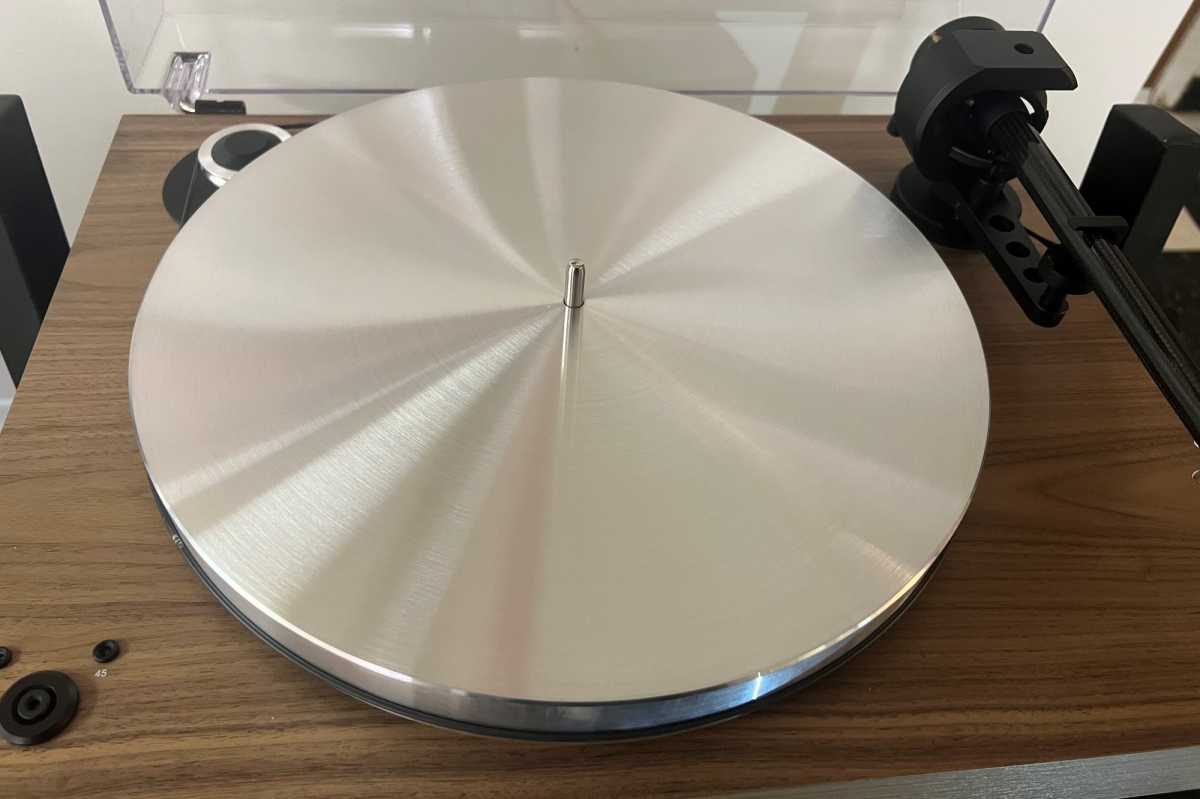
The Pro-Ject X8 turntable is equipped with a massive 11.24-pound lathed-aluminum platter.
James Barber/Foundry
To confirm this claim, we tested the Pro-Ject X8 two ways. First was with the pre-installed Sumiko Moonstone MM cartridge. The turntable was plugged into a NAD Phono Preamp PP-1 through a NAD Stereo Preamplifier S100, a NAD Monitor Series Amplifier 2400, and a pair of vintage Bowers & Wilkins P5 floor-standing speakers.
The second round of listening was to try out the True Balanced connection. I first installed the Sumiko Blue Point No. 3 MC cartridge ($299). I swapped the included Connect it Phono E 5P RCA cable for Pro-Ject’s Connect it Phono 5P-CC XLR Neutrik balanced cable ($219) and replaced the NAD Phono Preamp PP-1 with Pro-Ject’s new Phono Box DS3 B phono stage ($799).
Before we get to the results of the listening tests, let’s look at the X8 turntable’s features.
The Pro-Ject X8 is a well-built turntable

The Pro-Ject X8 turntable belt wraps around the outside of the platter.
James Barber/Foundry
The X8 has an 11.24-pound platter that’s precision lathed and balanced from a single piece of aluminum and features TPE (thermoplastic elastomer) damping. The center hole of the platter goes over a ceramic-tipped inverted bearing with a neodymium magnet that allows for smooth rotation despite the platter’s weight.
A massive MDF plinth supports the platter and is available in high-gloss white, high-gloss piano black, with a walnut veneer. The entire unit weighs 33 pounds. The X8’s dimensions with its high-quality clear acrylic dust cover closed are 18.3 x 5.9 x 13.8 inches (WxHxD), while dimensions with the lid opened are 18.3 x 16.3 x 16.5 inches.
The X8 comes with Pro-Ject’s 9cc EVO carbon tonearm. Its headshell and arm tube are made from a single piece of carbon fiber in a conical shape, which eliminates standing wave reflections. The inverted bearing, the 9cc EVO tonearm, and the counterweight are all designed to prevent resonance. In addition to the audio cable previously mentioned, the turntable also ships with a 15V DC power supply, an adapter for 7-inch singles, and a felt mat.
Assembling the Pro-Ject X8 for first use
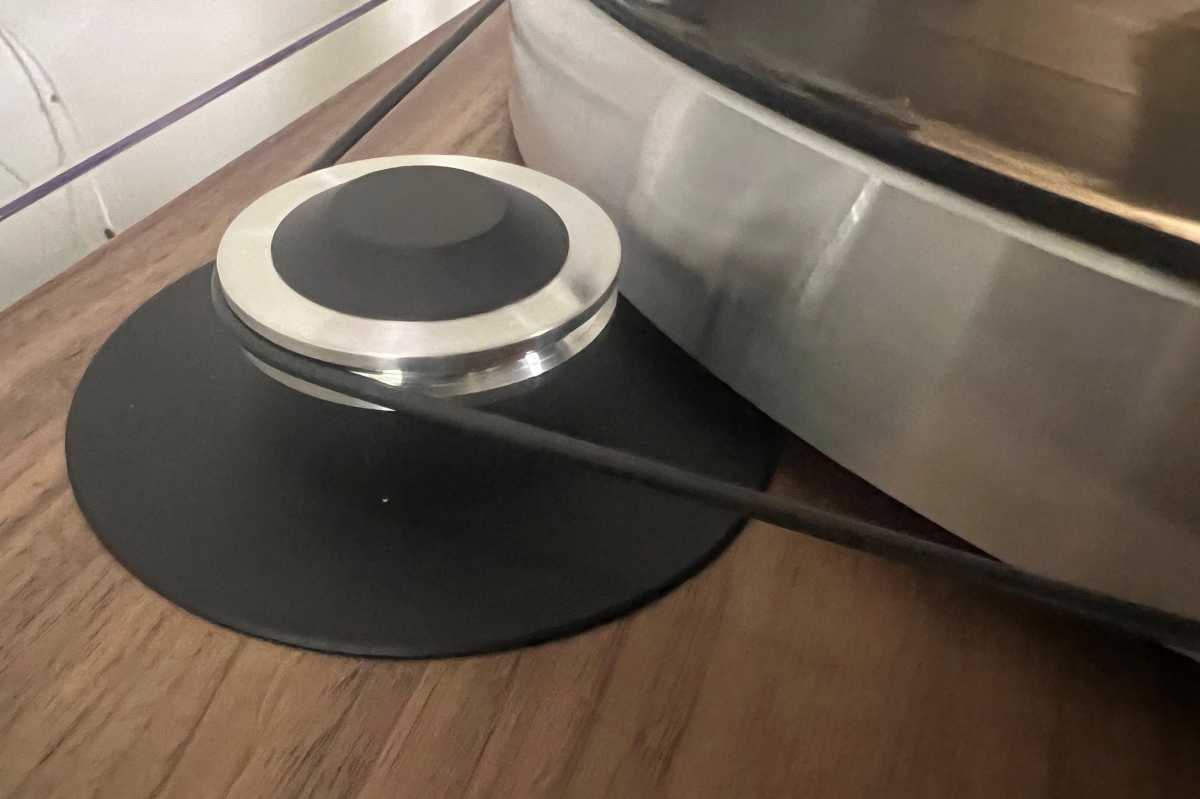
The Pro-Ject X8 turntable has a powerful motor to drive its heavy platter.
James Barber/Foundry
Aside from the fact that the plinth and platter are so heavy, setup was simple. Since the belt wraps around the outside of the platter and the motor pulley is exposed on the plinth, there’s none of the frustrating process that comes with attempts to stick a finger between the belt and the platter and navigate that belt around a pulley via in a hole in the platter.
Tonearm setup was even easier. The Sumiko cartridge was preinstalled, so all that was required was to slide on the counterweight, balance the tonearm, set the counterweight meter to zero, add the anti-skate weight, and set the proper tracking force.
Installing a counterweight on a tonearm can be one of the most frustrating and confusing for the new vinyl enthusiast. Entry-level Pro-Ject turntables are easier to set up than most, but the 9cc EVO tonearm is leagues better and by far the best experience I’ve ever had installing a counterweight.
Operating the Pro-Ject X8

The Pro-Ject X8 turntable’s speed is controlled by a button on the top of the plinth
James Barber/Foundry
The Pro-Ject X8 is a completely manual turntable. There’s an on/off switch under the left front of the plinth and a button on top that lets you choose 33- or 45rpm. There’s a lever to raise the tonearm and then lower it onto your spinning vinyl. And that’s it.
The turntable doesn’t automatically return the tonearm to its rest at the end of a side or even stop spinning. Listening to vinyl with the X8 is a fully engaged experience. You place a record on the platter, clean it if you haven’t used a freestanding record cleaning machine already, turn on the motor, lower the tonearm and sit back to enjoy 23 minutes or less of music. (Let’s hope it’s not more than 23 minutes, because no one’s ever managed to make great-sounding vinyl that can handle more music than that on a side.)
When it’s over, you’ll need to either get up—or stop dancing—and walk over to the turntable and lift the tonearm so that your stylus doesn’t get damaged by repeatedly banging against the record’s runout groove.
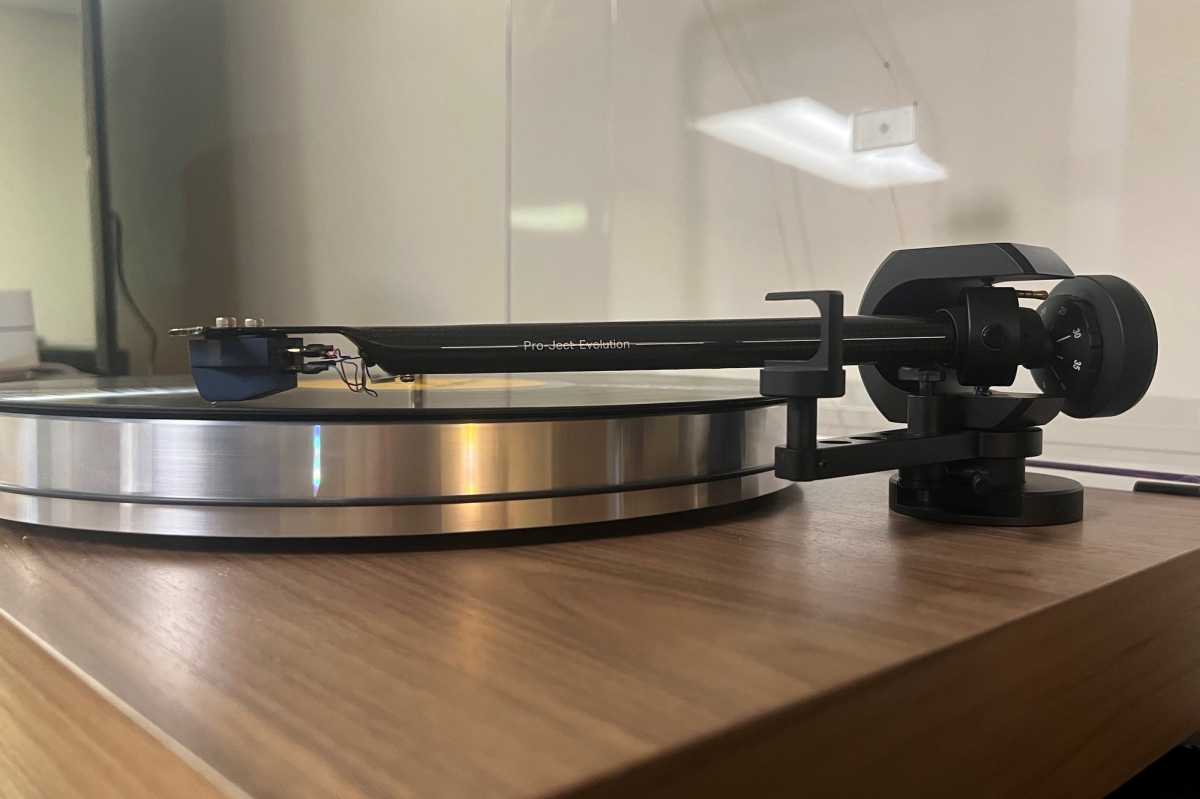
The Pro-Ject X8 turntable comes with a carbon-fiber tonearm.
James Barber/Foundry
Let’s stop for a minute and address the dancing. Part of what you get with all this weight with the X8 is a turntable that can absorb whatever vibration is happening in the room. Vinyl just would not skip no matter what banging was going on in the room. It’s an impressive feat and a big reason why this turntable justifies its cost.
The new generation of vinyl enthusiasts will tell you that the requirement that listeners focus on raising and lowering the tonearm inspires more intentional listening, and that vinyl’s short playing time and mechanical requirements are a feature and not a bug.
Anyone who experienced the transition from vinyl to CD back in the 1980s might disagree. The fact that there was a new format that allowed for 70-plus minutes of uninterrupted listening was a boon for romantic encounters all over the world.
Why listen to vinyl?
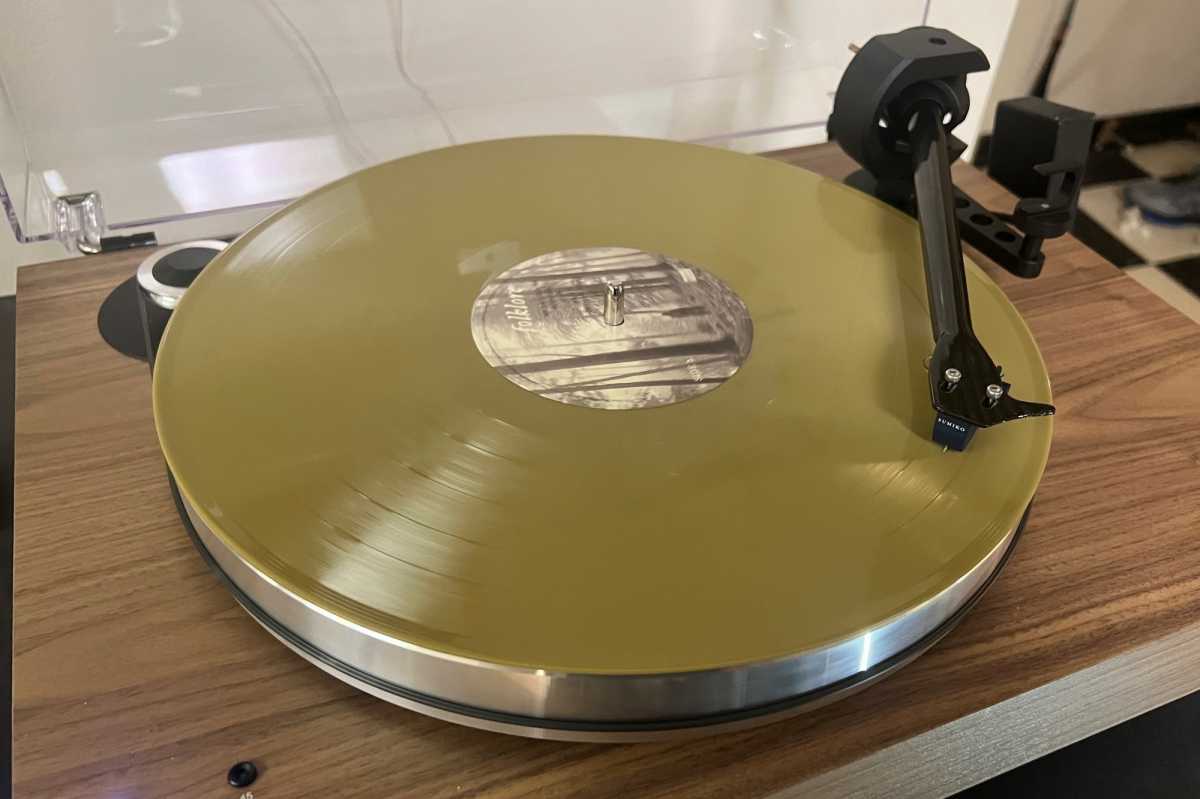
When playing Taylor Swift’s Grammy-winning folklore LP on the Pro-Ject X8, the vinyl version delivers a pleasing sound that’s different than what you’ll hear with a CD or digital stream.
James Barber/Foundry
The Pro-Ject X8 is a great turntable that helps make the case for vinyl as a listening format. Records, however, have limitations as a hi-fi audio format, even though some of those limitations are touted as the very reasons why vinyl is superior to all other ways to listen to music.
Vinyl can only reproduce a limited range in the middle of the audio spectrum, and capturing those previously unattainable highs and lows was a big motivation behind the invention of the compact disc and the eventual move to high-resolution digital audio.
The “warmth” that vinyl advocates promote is a combination of that enhanced midrange and the surface noise that’s present on almost every slab of vinyl ever pressed. For listeners who first heard music this way, there’s an understandable nostalgia for the format and for the kind of sound vinyl provides.
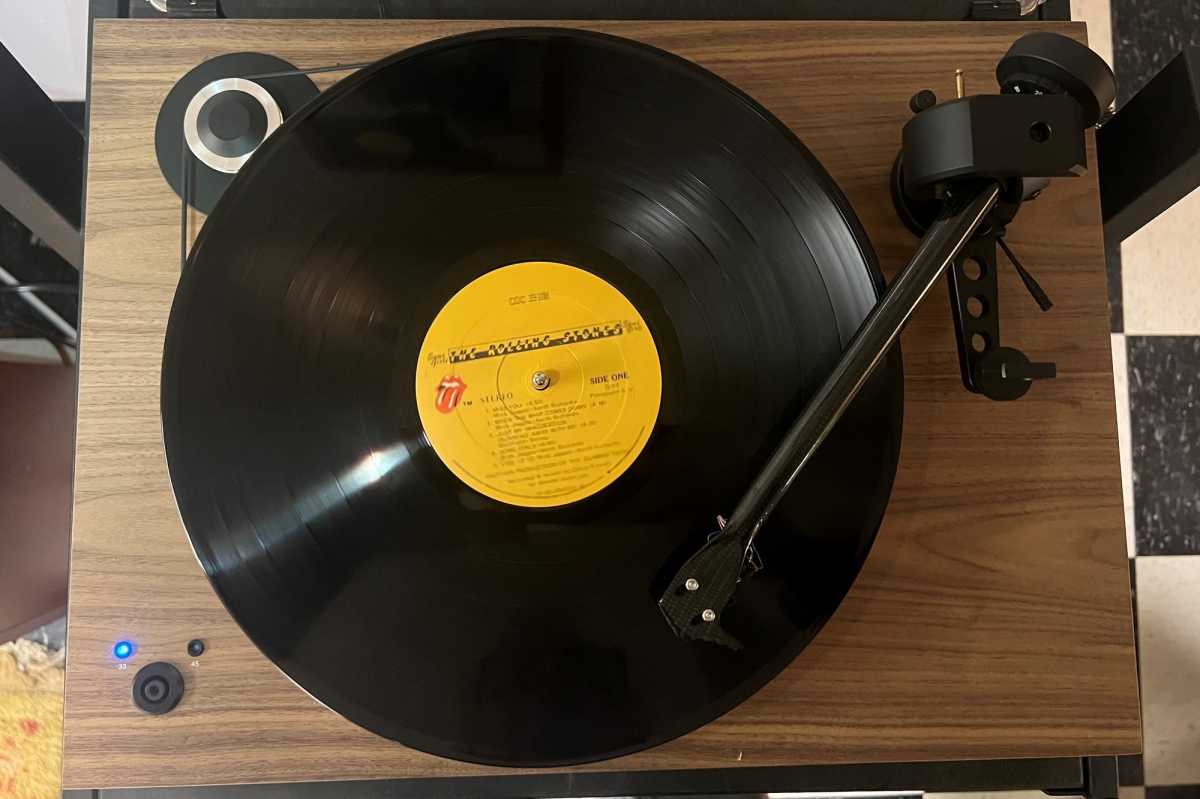
The Pro-Ject X8 turntable can track almost any LP, no matter how warped or worn.
James Barber/Foundry
Here’s where things get dicey. Music recorded during the LP and 45 era (the late 1950s to the early 80s) was supervised by engineers who were painfully aware of the limitations of the format. Most did their best to make sure that they recorded music in such a way that it would sound good on an LP.
CDs broadened the range available to producers and engineers, and most of them enthusiastically embraced the format even though it still had limitations in the range of sound the format could reproduce. By the time we arrive in the pure digital era, almost no one is focused on those limitations anymore.
For me, a turntable like the Pro-Ject X8 is best suited to play music recorded during the first vinyl era, and preferably from a pressing made around the time of the original release. I used this turntable to put some of those ideas to the test.
Pro-Ject X8 listening tests
I recently scored an early copy of The Rolling Stones 1978 LP Some Girls at a Goodwill store and purchased a clean copy of Linda Ronstadt’s 1978 LP Living in the USA at my local record store. After both were cleaned with a vintage Discwasher record cleaning brush, they played with an acceptable amount of surface noise.
My baseline setup is a Technics SL-1200 turntable with an Ortofon OM 10 cartridge and stylus plugged into the NAD Phono Preamp PP-1 mentioned above. The SL1200 is a direct-drive workhorse that has been a favorite of DJs for decades, and the Ortofon is an outstanding value-priced cartridge.
Switching to the Pro-Ject X8 and the Sumiko Moonstone MM cartridge plugged into the NAD revealed new details in both LPs. There was better definition for each individual instrument without losing the warmth that vinyl listeners celebrate. A lot of that improvement should be attributed to the $299 Moonstone cartridge, an upgrade available for owners of any turntable that can use a moving magnet cartridge.
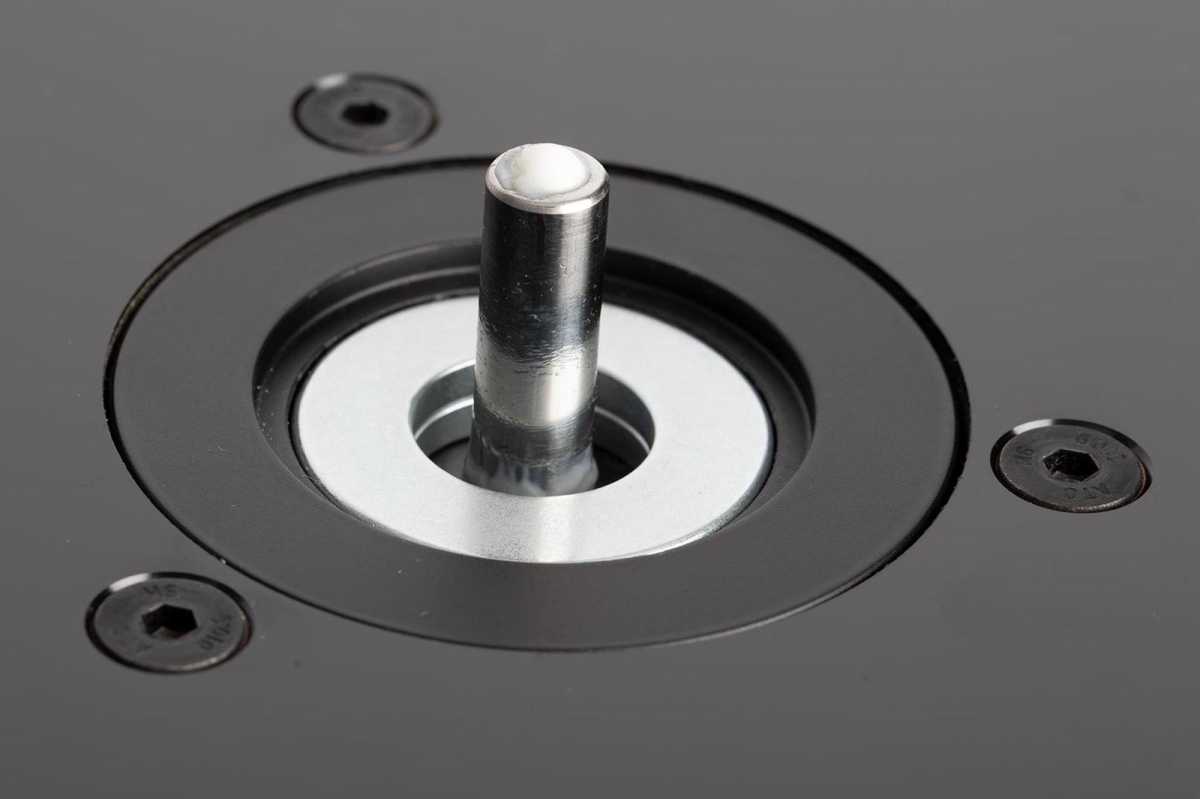
The Pro-Ject X turntable features a ceramic-tipped inverted bearing with a neodymium magnet to ensure the turntable spins at the proper speed.
James Barber/Foundry
It’s the True Balanced connection that’s the real selling point for the Pro-ject X8. Yes, the massive platter and motor will offer listeners far better tracking overall, and their value should not be dismissed, but Pro-Ject is selling the XLR connections as the main feature of this model.
Switching to the XLR cable and the Sumiko Blue Point No. 3 MC cartridge plugged into the Pro-Ject Phono Box DS3 B phono stage was a revelation. The DS3 B is a versatile and impressive phono stage that allows a listener to plug in two different turntables. You can read my Proj-Ject Phono Box DS3 B review for full details.
Both the Stones and Ronstadt LPs had a wider soundstage and even more of that celebrated vinyl warmth when played through this setup. This sound chain seemed to dig out even more bass thump from this disco arrangement of The Rolling Stones “Miss You” and the guitars in “Before They Make Me Run” have a razor-sharp quality that I’ve never really heard on any reissues of this album in any format.
Living in the USA was recorded at the peak of Ronstadt’s collaboration with producer Peter Asher and engineer Val Garay, and the arrangements are particularly notable examples of what a great recording team can do when focused on producing music for the vinyl format. When played through the balanced setup, “Just One Look” both rocks and allows the listener to hear the details of the band’s placement in the mix and even identify individual voices in the backing vocals.
There are turntables costing many thousands of dollars more that deliver this kind of listening experience, but the Pro-Ject X8 is relatively affordable way to begin to hear what high-end turntable aficionados are raving about.
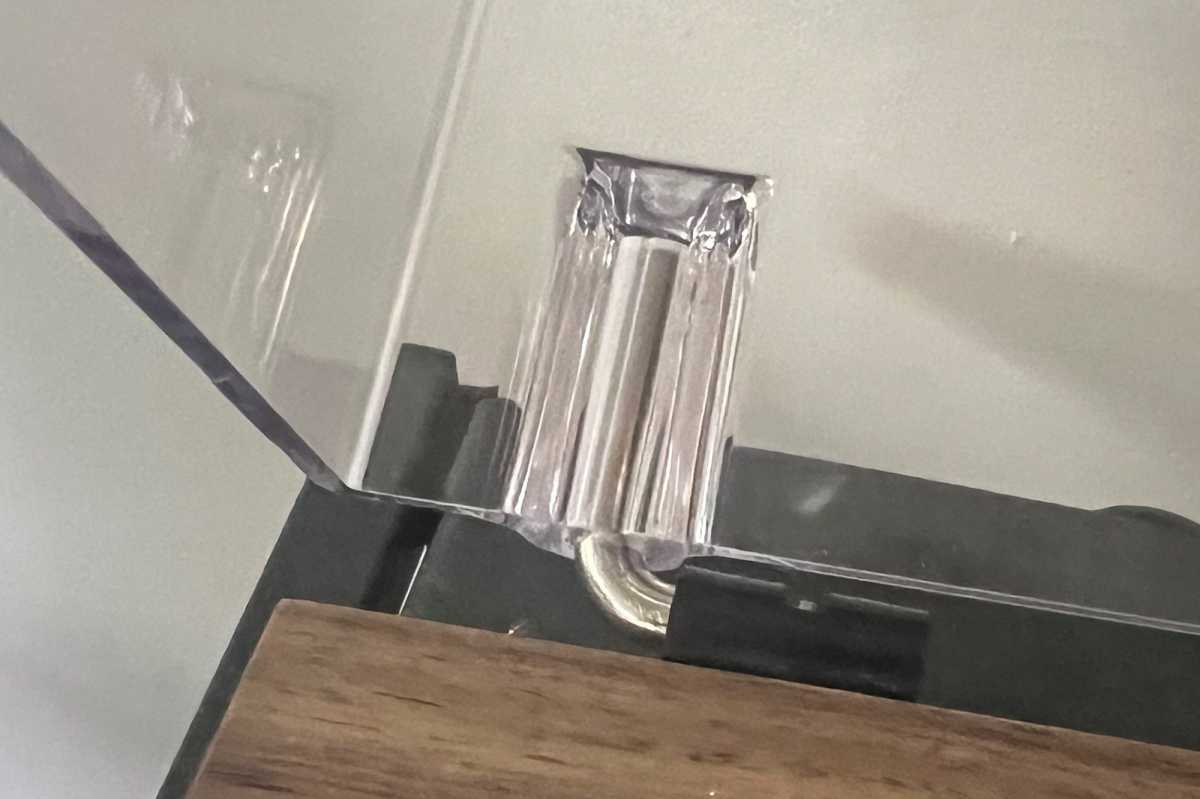
The Pro-Ject X8 turntable’s hinge and cover are exceptionally well made
James Barber/Foundry
I decided that I needed to challenge everything I’ve said so far about the golden era of vinyl in the context of reviewing this turntable, so I went to my local chain bookstore and bought a vinyl pressing of Taylor Swift’s Grammy-winning 2020 album folklore. I already own a CD and just set up an Audiolab 6000N Play wireless streaming player that allows me to stream tracks from Qobuz at high resolution. How does this beautifully recorded album sound when played back in its various formats?
The vinyl version sounds really nice when played on the X8 through the Phono Box DS3 B. Aside from a noticeable amount of surface noise from the very first listen (a problem that plagues modern pressings from a surprising number of vinyl plants), there’s a warmth to the music that’s engaging. “Mirrorball” has a pleasant midrange buzz that envelops Swift’s lead vocal in the kind of haze that vinyl lovers celebrate
The compact disc, however, reveals substantially more detail. There’s more separation between the instruments and far more precision in the mix. There starts to be a discrete separation between Swift’s vocal and the backing track. The CD sounds great.
And then you hear the hi-res audio playback. Folklore sounds like an entirely different recording when compared to the vinyl. The Audiolab is an entry-level streaming component, but it does natively stream Qobuz high-res content. There’s a startling amount of detail, absolute separation between instruments, but with a coherent presentation. It’s a complete mix and not just a collection of stems playing at the same time.
There’s a strong case that Swift and co-producers Jack Antonoff and Aaron Dessner were recording and mixing this music with hi-res audio in mind. Just like Peter Asher and Val Garay were thinking about the requirements for vinyl mastering back in the 70s, the current generation of producers and engineers are drawn to the highest playback quality possible.
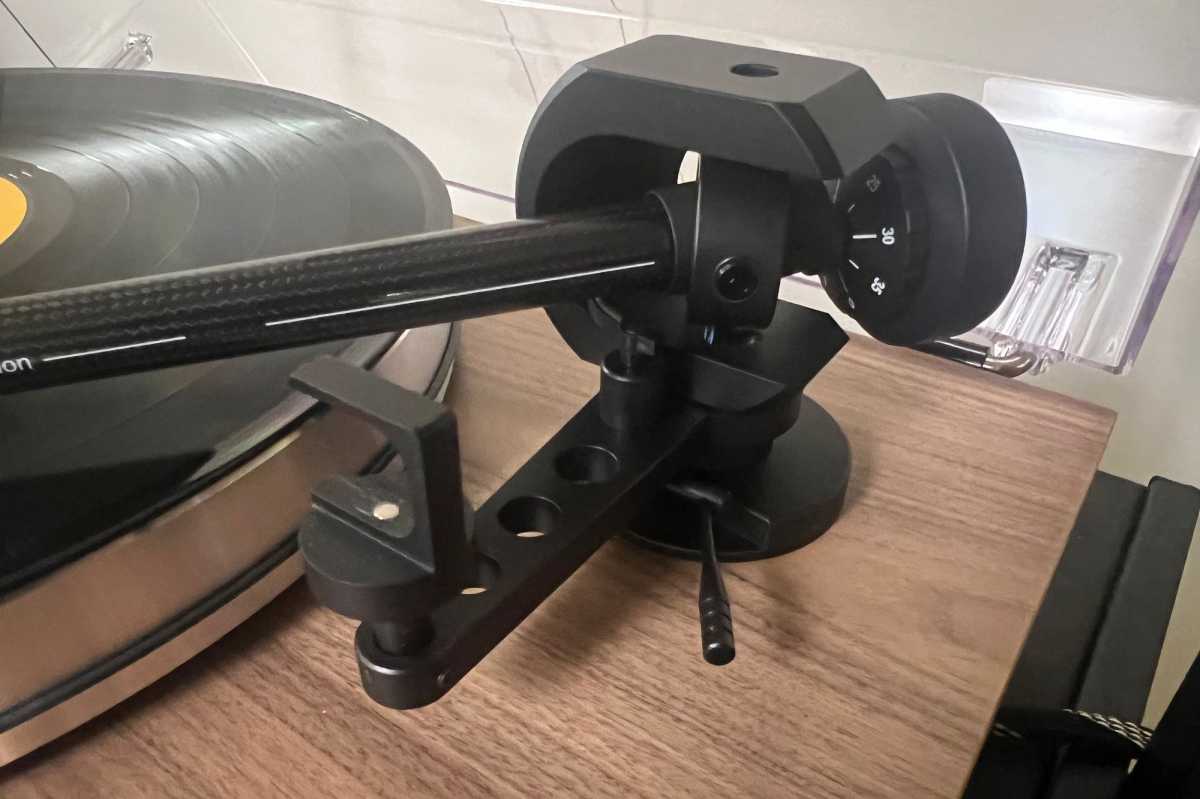
The Pro-Ject X8 turntable’s counterweight is satisfyingly easy to balance.
James Barber/Foundry
Does that mean you shouldn’t play new music on a turntable? That’s not the point. Listening to folkore on vinyl has a pleasant fuzziness that the high-res audio stream lacks. Some listeners will prefer that “analog” vibe and never embrace the enhanced detail high-res audio can offer, even though the vinyl release is missing some of the audio data the creators wanted them to hear.
Music originally recorded for LP will probably always be most engaging when a clean pressing is played with a proper turntable setup. A lot of contemporary music will likely sound best in a quality digital format. No format is inherently superior to any other, and your results largely depend on the way the music was recorded in the first place.
None of the above is a criticism of the Pro-Ject X8 or the Phono Box DS3 B. Nor is it a complaint about Taylor Swift. It’s just a bracing reminder that everyone should set their expectations about source material when choosing how to listen to music.
Is the Pro-Ject X8 worth it?
The Pro-Ject X8 elevates the entire experience of playing an LP. This turntable offers spectacular build quality with its heavy plinth and extremely heavy platter. There’s something about a motor as it drives such weight that makes a spinning record seem far more substantial than what you experience with more lightweight turntables.
Pro-Ject’s carbon tonearm is equally amazing. When properly balanced, there’s a sense that the cartridge is almost floating across your vinyl but there’s never a sense that your records are likely to skip.
Ultimately, though, anyone who’s buying the Pro-Ject X8 should also be investing in a phono stage that takes advantage of its ability to use balanced XLR connectors. The balanced connection combined with a moving coil cartridge removes just enough distortion and adds just enough detail to the playback that it’s worth that extra investment to maximize the X8’s capabilities. The Pro-Ject Phono Box DS3 B phono stage proved an excellent way to enjoyed that balanced listening experience. Pro-Ject has delivered a pair of products that allow listeners to experience the benefits of high-end audiophile technology at a price that’s far less than you’d expect. If you’re ready to upgrade your system, the X8 turntable is an excellent step as you start to move into audiophile territory.




